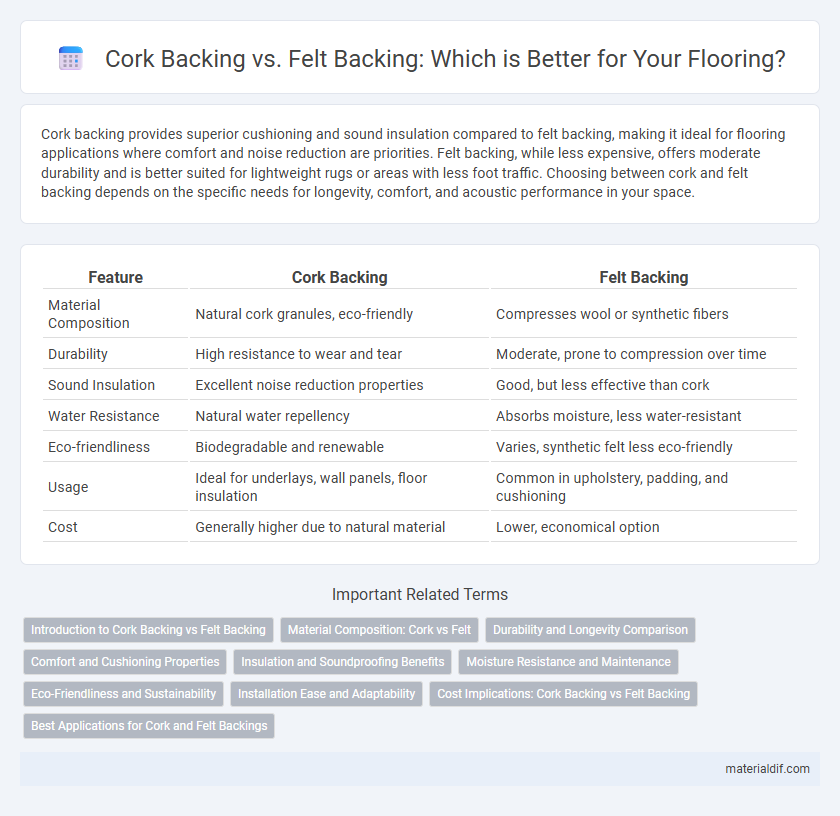Cork backing provides superior cushioning and sound insulation compared to felt backing, making it ideal for flooring applications where comfort and noise reduction are priorities. Felt backing, while less expensive, offers moderate durability and is better suited for lightweight rugs or areas with less foot traffic. Choosing between cork and felt backing depends on the specific needs for longevity, comfort, and acoustic performance in your space.
Table of Comparison
| Feature | Cork Backing | Felt Backing |
|---|---|---|
| Material Composition | Natural cork granules, eco-friendly | Compresses wool or synthetic fibers |
| Durability | High resistance to wear and tear | Moderate, prone to compression over time |
| Sound Insulation | Excellent noise reduction properties | Good, but less effective than cork |
| Water Resistance | Natural water repellency | Absorbs moisture, less water-resistant |
| Eco-friendliness | Biodegradable and renewable | Varies, synthetic felt less eco-friendly |
| Usage | Ideal for underlays, wall panels, floor insulation | Common in upholstery, padding, and cushioning |
| Cost | Generally higher due to natural material | Lower, economical option |
Introduction to Cork Backing vs Felt Backing
Cork backing provides natural insulation, moisture resistance, and sound absorption, making it ideal for flooring underlays and wall applications. Felt backing, typically made from synthetic or recycled fibers, offers durability and cushioning but lacks the eco-friendly benefits and thermal properties of cork. Understanding the distinct material compositions and performance characteristics helps determine the best choice for specific building or crafting needs.
Material Composition: Cork vs Felt
Cork backing consists of natural cork granules harvested from the bark of cork oak trees, providing excellent cushioning, moisture resistance, and eco-friendly properties. Felt backing is typically made from compressed fibers such as wool, polyester, or recycled materials, offering durability and sound absorption but less moisture resistance compared to cork. In Cork, choosing cork backing enhances insulation and sustainability, while felt backing is favored for its durability and noise reduction in various applications.
Durability and Longevity Comparison
Cork backing offers superior durability compared to felt backing due to its natural resilience and resistance to moisture, making it ideal for high-traffic areas in Cork's variable climate. Felt backing, while softer and more flexible, tends to degrade faster under heavy use and exposure to damp conditions, reducing its overall longevity. Choosing cork backing ensures a longer-lasting floor covering that withstands wear and environmental factors typical in Cork homes.
Comfort and Cushioning Properties
Cork backing provides superior comfort and cushioning due to its natural elasticity and shock-absorbing properties, making it ideal for flooring applications where fatigue reduction is essential. Felt backing offers a softer underlayer that enhances cushioning but lacks the resilience and durability of cork, which can compress over time. The thermal insulation and moisture resistance of cork backing further contribute to maintaining consistent comfort levels in various environments.
Insulation and Soundproofing Benefits
Cork backing offers superior natural insulation and soundproofing properties compared to felt backing due to its dense cellular structure that effectively reduces heat transfer and absorbs sound waves. Felt backing provides moderate insulation and sound dampening but lacks the thermal efficiency and moisture resistance of cork. Choosing cork backing enhances energy efficiency and minimizes noise pollution, making it ideal for both residential and commercial applications where comfort and quietness are priorities.
Moisture Resistance and Maintenance
Cork backing offers superior moisture resistance compared to felt backing, making it ideal for damp environments and reducing the risk of mold and mildew. Maintenance for cork-backed materials is simpler due to their natural water-repellent properties, requiring less frequent cleaning and less risk of water damage. Felt backing absorbs moisture easily, leading to higher maintenance needs and potential deterioration over time in humid conditions.
Eco-Friendliness and Sustainability
Cork backing is significantly more eco-friendly than felt backing due to its natural, renewable harvesting process and biodegradability, minimizing environmental impact. Felt backing, often made from synthetic fibers or blended materials, tends to have a higher carbon footprint and challenges in recycling. Choosing cork backing supports sustainability by promoting renewable resources and reducing landfill waste.
Installation Ease and Adaptability
Cork backing offers superior installation ease compared to felt backing due to its lightweight and flexible nature, allowing for quicker and more precise application on uneven surfaces. Felt backing, while durable, often requires additional adhesives and careful handling to prevent shifting during installation, making it less adaptable to irregular floors. Cork's natural elasticity enhances adaptability, providing better conformity to subfloor imperfections and reducing installation time and complexity.
Cost Implications: Cork Backing vs Felt Backing
Cork backing generally incurs higher initial costs due to its natural, durable material but offers long-term savings through enhanced insulation and longevity. Felt backing, being more economical upfront, may require more frequent replacements, increasing maintenance expenses over time. Evaluating total lifecycle expenses reveals cork backing as a cost-effective choice for sustainable flooring solutions in Cork.
Best Applications for Cork and Felt Backings
Cork backing provides excellent moisture resistance and cushioning, making it ideal for underlayment in hardwood floors and soundproofing in residential spaces. Felt backing offers superior durability and thermal insulation, which suits heavy-traffic commercial areas and upholstery applications. Choosing the right backing depends on the specific requirements for durability, moisture control, and comfort in each Cork installation.
Cork Backing vs Felt Backing Infographic

 materialdif.com
materialdif.com